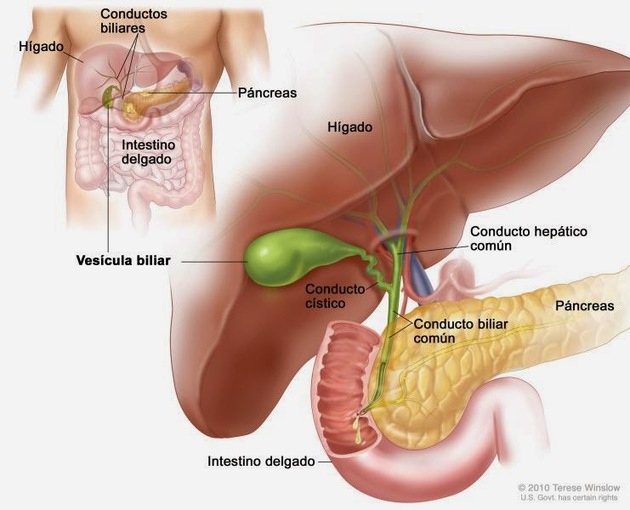The gallbladder is a muscular organ that is located close to the liver and acts on the digestive system.
Its main function is to store bile, which is produced by the liver. It aids in digestion in the process of dissolving and using the ingested fat, stimulating the secretion of cholecystokinin (CCK) and neutralizing acids until it reaches the intestine.
Anatomy of the Gallbladder
The anatomy of the gallbladder is shaped like a pear and can measure between 7 and 10 cm in length.
It has a dark green color due to the bile it stores, approximately 50 ml. Its main components are water, sodium bicarbonate, bile salts, pigments, fats, inorganic salts and cholesterol .
The gallbladder is connected to the liver and duodenum by the biliary tract, also presenting right and left hepatic ducts, cystic and choledochal.
The bile produced by the liver travels through the hepatic duct, passes through the intestine and meets the cystic duct from the gallbladder. The meeting of these two ducts form the bile duct.
In the duodenum, when the bolus arrives, a stimulus is triggered in the gallbladder, which contracts and releases bile, facilitating digestion .

Gallbladder diseases
Blocking the flow of bile through the cystic duct is considered the most common reason for gallbladder diseases. In addition, the gallbladder can present problems such as inflammation and infection.
Below are the main diseases related to the gallbladder.
Cholelithiasis
One of the most common diseases, cholelithiasis is also known as gallstone or gallbladder stone.
There is no single cause for this disease. The most common factors are genetic inheritance , diet, body weight and high cholesterol levels.
People who have gallbladder stones do not always show symptoms, which can be mistaken for stomach pains, kidneys and, in some cases, even back pain.
The pains are usually intense and gradual. To identify the stones in the gallbladder, ultrasound of the abdominal region is performed.
The treatment for cholelithiasis is surgery to remove stones and gallbladder, because if the gallbladder ruptures, there is the possibility of inflammation and infection.

Cholecystitis
Inflammation of the gallbladder usually occurs in people who have gallstones. It is also related to the complication of other diseases.
Its main symptoms are abdominal pain, nausea, vomiting and tenderness to the abdomen.
Cholecystitis can be acute or chronic. The acute cholecystitis appears abruptly, with sharp pains in the upper abdomen, and can be mitigated with antibiotic medication.
The chronic cholecystitis is more serious and affects people who have gallstones and its treatment is emergency surgery.

Sclerosing cholangitis
This disease represents the narrowing of the bile ducts due to their inflammation and scarring. The tissue formed by healing does not allow the passage of substances that assist in the absorption of fat.
Because it is related to the activities of the liver and gallbladder, the main consequences of sclerosing cholangitis can be liver failure, cirrhosis and, in some cases, cancer.
Treatment may vary according to the symptoms presented. For the simplest cases, it is recommended only to monitor the evolution of the disease. In more advanced cases, liver transplantation may be necessary.
Difference between gallstone and kidney stone
Gall bladder stones and kidney stones are diseases with very similar symptoms that can be confused. See the table below for a comparison between these two diseases.
| Gallstones | Renal stone | |
|---|---|---|
| What are | They are the gallstones and are located in the gallbladder or in any of its ducts. | Popularly known as kidney stone, it can be found both in the kidneys and in other organs of the urinary system. |
| Causes | There is no specific reason, however, the most common is related to cholesterol, that is, fats that are not dissolved by bile. | The main cause is the low intake of water, which generates low volume of urine. |
| How to differentiate | The main characteristic is the pain in the front of the abdomen, being intense and sudden, causing nausea and vomiting. | The pain is severe and intense in the abdominal region, however, located in the back. The presence of blood in the urine is also common in these cases. |
| Treatment | In most cases, surgery to remove the gallbladder is recommended. | The stones are spontaneously eliminated through the urine. |
